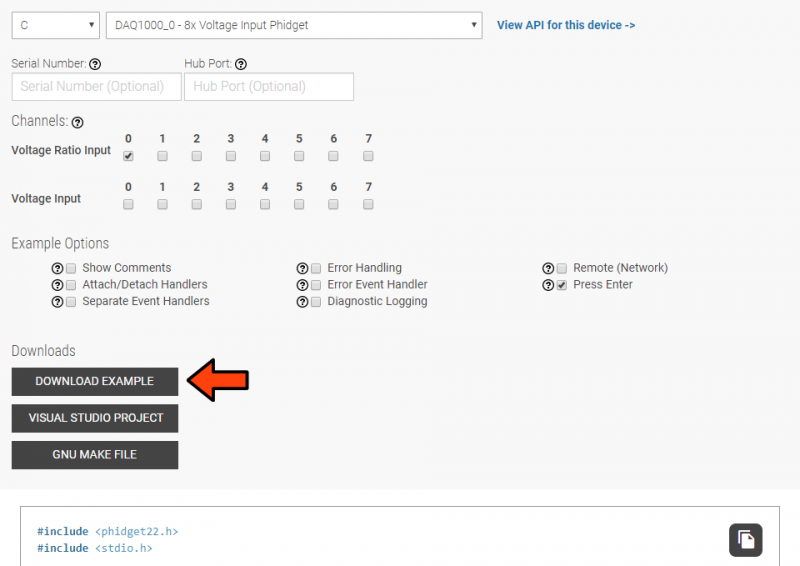Language - C macOS GCC: Difference between revisions
No edit summary |
No edit summary |
||
| Line 8: | Line 8: | ||
Welcome to using Phidgets with C! By using C, you will have access to the complete Phidget22 API, including events. | Welcome to using Phidgets with C! By using C, you will have access to the complete Phidget22 API, including events. | ||
GCC is a compiler system | GCC is a compiler system originally written for GNU, and is the standard compiler on unix-like operating systems. GCC is readily available on macOS, and can be used to compile C programs from the terminal. | ||
|{{TOC limit|2}} | |{{TOC limit|2}} | ||
|} | |} | ||
{{Language_-_C_Intro|macOS|GCC}} | {{Language_-_C_Intro|macOS|GCC}} | ||
{{Finding Code Samples|C}} | |||
==Using the Code Samples== | |||
To use the code sample from the [{{server}}/?view=code_samples&lang=C Code Samples] page, you can click the '''Download Example''' button to download a C file with the sample code. | |||
[[Image:C_Sample_Code_Download.png|link=|center|800px]] | |||
Once you have the example, you can compile and run your code: | |||
== | ==Compile and Run== | ||
To compile C programs, you will need gcc. You likely have gcc installed on your macOS machine already, but if not, you can easily get it by downloading [https://developer.apple.com/xcode/ Xcode]. | To compile C programs, you will need gcc. You likely have gcc installed on your macOS machine already, but if not, you can easily get it by downloading [https://developer.apple.com/xcode/ Xcode]. | ||
To compile the program, enter the following command in the terminal, substituting "example" for the name of your C file: | To compile the program, enter the following command in the terminal, substituting "example" for the name of your C file: | ||
| Line 58: | Line 37: | ||
</syntaxhighlight> | </syntaxhighlight> | ||
Success! The project now | Success! The project is now running with Phidgets. | ||
{{Language Page What's Next}} | {{Language Page What's Next}} | ||
Revision as of 21:14, 16 October 2019
|
Language - C macOS with GCC Welcome to using Phidgets with C! By using C, you will have access to the complete Phidget22 API, including events. GCC is a compiler system originally written for GNU, and is the standard compiler on unix-like operating systems. GCC is readily available on macOS, and can be used to compile C programs from the terminal. |
Install Phidget Drivers for macOS
Before getting started with the guides below, ensure you have the following components installed on your machine:
- You will need the Phidgets macOS Drivers
Finding Code Samples
To find the code sample to use for your Phidget, navigate to the Code Samples page and select your device from the drop-down menu.
Once you select your device, the code sample generator will give you a working code sample, and a selection of options to customize it to your needs.
Using the Code Samples
To use the code sample from the Code Samples page, you can click the Download Example button to download a C file with the sample code.

Once you have the example, you can compile and run your code:
Compile and Run
To compile C programs, you will need gcc. You likely have gcc installed on your macOS machine already, but if not, you can easily get it by downloading Xcode.
To compile the program, enter the following command in the terminal, substituting "example" for the name of your C file:
gcc example.c -o example -F /Library/Frameworks -framework Phidget22 -I /Library/Frameworks/Phidget22.framework/Headers
Finally, run the program by entering the following command in the terminal:
./example
Success! The project is now running with Phidgets.
What's Next?
Now that you have set up Phidgets to work with your programming environment, we recommend you read our guide on Phidget Programming Basics to learn the fundamentals of programming with Phidgets.![]()

